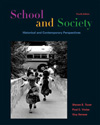In a number of ways, Chapter 4 is a pivotal chapter for this textbook. It examines perhaps the most dramatic changes in political economy, ideology, and schooling to take place in U.S. history. While the Jeffersonian chapter treated the first fifty years of the American republic and the common schooling chapter treated the beginnings of industry and accompanying transitions in classical liberalism of the next fifty years, Chapter 4 unveils the modern era in American culture and schooling that emerged in the half-century from the 1870s to the 1920s. Chief political-economic changes included the emergence of a largely urban society, immigration from new sources in Asia and southern and eastern Europe, and far-reaching new developments in industrialization and monopoly capitalism. Ideologically, classical liberalism was transformed by political, economic, and intellectual developments into a new form of liberalism, variously termed "new," "modern," or "corporate" liberalism. This revised liberalism maintained commitments to scientific rationality, progress, and freedom, but it transformed these commitments to be consistent with the need of the emerging leaders of government and business to justify expert and bureaucratic control and social, political, and economic institutions in American culture. The chapter's first page uses the Gary school system as an illustration of how schools themselves were transformed, and how this transformation was publicly justified during the Progressive Era. School reform became a major priority on the national agenda for members of the business community, journalists, social reformers, educators, and educational psychologists who began to explain human learning in decidedly new terms. As a result of these reform efforts, new objectives for schooling emerged, including: training students with employable skills in the industrial workforce; enhancing social stability through an education that would adjust students to the political and economic hierarchies of the twentieth century; providing a form of equal educational opportunity that assumed markedly different talents among students and offered different curricula for those different talents; and, finally, establishing a system of meritocracy that would appear to make different educational outcomes contingent only upon the talent and effort of the students themselves. To achieve these objectives, schools changed sharply in the Progressive Era in terms of who was required to attend school, the different curricula offered to the students who attended, the establishment of extra-curricular activities for social and educational aims, and the shift in control of schools from local neighborhoods to centralized school boards dominated by business and professional class membership and ideology. |



 2002 McGraw-Hill Higher Education
2002 McGraw-Hill Higher Education